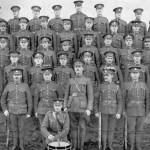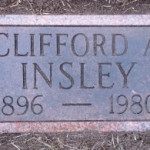

| Personal Details | |
| Date of Birth | October 22, 1896 |
| Place of Birth | Rat Portage (Kenora), Ontario |
| Country | Canada |
| Marital Status | Single |
| Next of Kin | John Insley, father, 370 Dufferin Street, Port Arthur, Ontario |
| Trade / Calling | Clerk |
| Religion | Methodist |
| Service Details | |
| Regimental Number | 73370 |
| Service Record | Link to Service Record |
| Battalion | 28th Battalion |
| Force | Canadian Expeditionary Force |
| Branch | Canadian Infantry |
| Enlisted / Conscripted | Enlisted |
| Date of Enlistment | October 23, 1914 |
| Age at Enlistment | 20 |
| Theatre of Service | Europe |
| Prisoner of War | No |
| Survived War | Yes |
| Death Details | |
| Date of Death | April 10, 1980 |
| Age at Death | 85 |
| Buried At | Riverside Cemetery, Thunder Bay, Ontario |
| Plot | Sec 3, Plot 230 |
Insley, Clifford Arthur
Clifford Arthur Insley was born on 22 October 1896 in Rat Portage (later renamed Kenora), Ontario. His father John Insley was from Brimington, Derbyshire in England, immigrating to Canada in 1882, while his mother Mary Jane Kittle was from Ontario. The couple married on 8 December 1886 in Port Arthur, giving birth to son John Leslie in July of 1888. By the time of the 1891 census the family was living in Virden, Manitoba with John’s occupation given as engineer. At some point after the birth of son Morris Edgar in 1892 in Virden, the family relocated to Rat Portage, giving birth to children Clifford, Cecil Ross (1898), Annie Adella (1902), and Lillias Margaret (1905). The 1901 Rat Portage census gave John’s occupation as ice dealer. By the time of the 1911 census the family was living in Port Arthur, with daughter Marion joining the family in 1908. Once again John Sr was working as an engineer.
Along with his brother John, Clifford signed his attestation papers on 23 October 1914 in Port Arthur. With blue eyes and fair hair, his occupation was given as clerk, year of birth as 1894, and his father John in Port Arthur as next of kin. The 28th Battalion originally recruited in Saskatoon, Regina, Moose Jaw and Prince Albert, Saskatchewan and Fort William and Port Arthur, Ontario and was mobilized at Winnipeg, Manitoba. As Privates with A Company, 3rd Platoon of the 28th Battalion, the brothers embarked from Montreal aboard the Northland on 29 May 1915 and by the end of September were in France. The 28th Battalion fought as part of the 6th Infantry Brigade, 2nd Canadian Division in most of the major battles in France and Flanders until the end of the war.
In December of 1915 Clifford attended a Brigade Machine Gun course, returning on the 25th. In March of 1916 he was granted an eight day leave. That June the 28th Battalion was involved in the Battle of Mont Sorrel, starting on the 2nd. During the second German attack, the Germans sprung a surprise on the Canadians by exploding four large mines under trenches of the 2nd Canadian Division covering the spur at the eastern outskirts of the ruins of Hooge and a company of the 28th Battalion was almost completely wiped out in the explosions.
From the 28th Battalion website:
June 6, 1916
‘A very heavy artillery barrage on the front and support lines started at 7:00 AM, and continued until 2:00PM. At 3:05 PM, the Germans explode 4 enormous mines under 200 yards of the Battalion’s frontline trenches (covering the eastern outskirts of Hooge) at Trenches 70, 71 & 72 which it is believed, with the serious bombardment, practically wiped out the garrison. Trenches 73-75 also suffered heavily. The men in the frontline and bombing posts suffered heavy casualties, including the men from ‘A’ Company who were almost wiped out. ‘A’ Company’s men came from the twin ports area at the head of the lakes in Ontario (Port Arthur and Fort William). As there were now no units in the battalion from Ontario, all future reinforcements for the Battalion were to come from Saskatchewan.
Private Fraser of the 31st Battalion recorded in his diary:
‘It was raining continuously where my unit lay, contained only one dugout, which sheltered an officer. The trench by this time was filled up with water, there being over a foot, and behind was a swamp. Everything became saturated with wet, the bread in the ration bags became a pulp, all eatables, except canned goods, were completely destroyed. Clothes and equipment weighed as heavy as lead. Shells were exploding all around sending up showers of mud and water. The wounded lay where they fell on the poisonous ground of Flanders. The attack came; the first rush was easily squashed by the’Imperials’ (British) troops on the Canadian left; but they overran the 28th Battalion, ‘who in the front line were wallowing in death’. The 31st Managed to fight them off, ‘notwithstanding the difficulties we were in, encumbered with the dead and wounded; the firing step smashed in places; in mud and wet; rifles half clogged; and though dazed and crazed we pull ourselves together, line the serviceable part of the parapet and blaze into the advancing enemy, who recoils in confusion. All we accomplished was to penetrate down to our old communication trench into Zouave Wood’. (from Sanctuary Wood & Hooge by Nigel Cave)
The Germans quickly captured the front lines but were stopped by fire from the 28th’s men in the support line and the 31st on the right flank in Zouave Wood. They held on to the support trenches along side the Menin Road and had repulsed the German assault with rifle & machine gun fire by 3:30 PM. This was accomplished, despite significant jamming problems with their Ross rifles. ‘B’ Company had few remaining men and ‘C&D’ Companies suffered many casualties. The effective strength of battalion was reduced to about 50%.’
Although both brothers were in the decimated A Company, Clifford survived unscathed. First reported missing after action on the 6th, by July his brother John was unofficially reported as a prisoner of war. In October Clifford was awarded a Good Conduct Badge and in August of 1917 he was granted a ten day leave to the UK. Perhaps due to an enlarged thyroid gland in his neck, in April of 1918 Clifford’s role with the battalion changed, employed as a clerk and promoted to Corporal in May. With the end of the war Clifford returned to England in April of 1919 and embarked for Canada aboard the Cedric on 19 May. Clifford was discharged from service on 3 June in Port Arthur.
Clifford’s brother John survived his internment in the POW camps and returned to Canada in January of 1919, discharged from service that March.
After the war Clifford was to make Port Arthur his home. Various Voters lists over the years listed his occupation as government grain inspector. At some point Clifford moved to Scarborough, Ontario where he died in the Centenary Hospital on 10 April 1980. He was predeceased by his mother Mary Jane in 1942, brother Cecil in 1945, his sister Lillias in 1950, his father John in 1952, his brother John in 1963, and his brother Morris. At the time of his death he was survived by his sisters Annie Shirley and Marion Insley. Along with most of his family, Clifford is interred in the Riverside Cemetery in Thunder Bay.
By Judy Stockham
photographs of Clifford and A Company, 3rd Platoon: 28th Battalion website
Clifford’s obituary: courtesy of the Thunder Bay Public Library
Clifford’s gravemarker photo: courtesy of Lynda Piilo






